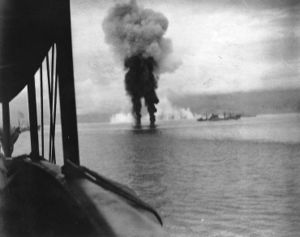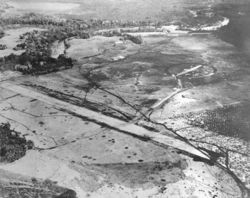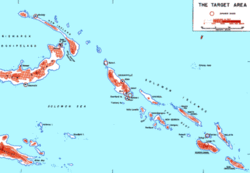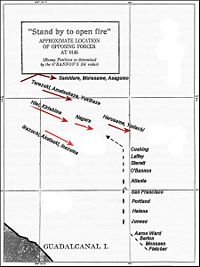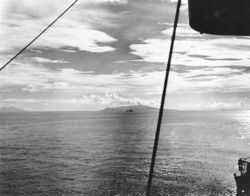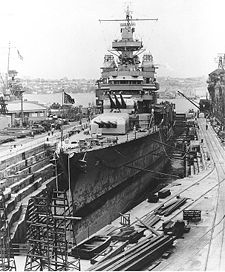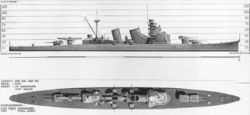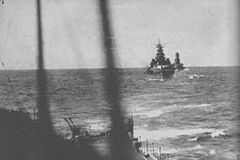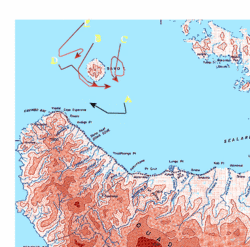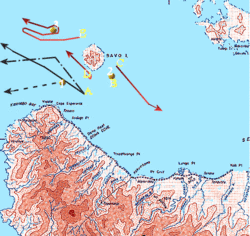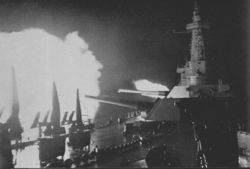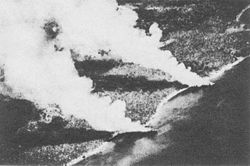Naval Battle of Guadalcanal
2008/9 Schools Wikipedia Selection. Related subjects: World War II
|
||||||||||||||||||||||||||||||
|
||||||||||||||||||||||||||||||
|
||||||||||||||||||||||||||||||
The Naval Battle of Guadalcanal, sometimes referred to as the Third and Fourth Battles of Savo Island, the Battle of the Solomons or, in Japanese sources, as the Third Battle of the Solomon Sea (第三次ソロモン海戦 ?), took place November 12 – November 15, 1942, and was the decisive engagement in a series of naval battles between Allied (primarily United States) and Imperial Japanese forces during the months-long Guadalcanal campaign in the Solomon Islands. The action consisted of combined air and sea engagements over four days, most near Guadalcanal and all related to a Japanese effort to reinforce land forces on the island.
Allied forces, primarily from the U.S., had landed on Guadalcanal on August 7, 1942 and seized an airfield, later called Henderson Field, that was under construction by the Japanese military. Several subsequent attempts by the Imperial Japanese Army and Navy, using reinforcements delivered to Guadalcanal by ship, to recapture the airfield failed. In early November 1942, the Japanese organized a transport convoy to take 7,000 infantry troops and their equipment to Guadalcanal to attempt once again to retake the airfield. To allow the convoy to approach the island and deliver its cargo, the Japanese navy sent several warship forces to bombard Henderson Field with the goal of destroying Allied aircraft stationed at the airfield that posed a threat to the troop convoy. Learning of the Japanese reinforcement effort, U.S. forces prepared to interdict the Japanese convoy and warships with aircraft and warship attacks.
In the resulting battle, both sides lost numerous warships in two extremely destructive nighttime surface engagements, with the U.S. suffering more warships sunk or heavily damaged than the Japanese. The U.S., however, was successful in turning back attempts by the Japanese to bombard Henderson Field with battleships. Air attacks by Allied aircraft also sank most of the Japanese troop transports and prevented the majority of the Japanese troops and equipment from reaching Guadalcanal. The battle turned back Japan's last major attempt to dislodge Allied forces from Guadalcanal and nearby Tulagi, resulting in a strategic victory for the U.S. and its allies and deciding the ultimate outcome of the Guadalcanal campaign in favour of Allied forces.
Background
The six-month Guadalcanal campaign began August 7, 1942, when Allied forces (primarily U.S.) landed on Guadalcanal, Tulagi, and the Florida Islands in the Solomon Islands, at the time a colonial possession of the United Kingdom. The landings were meant to deny the islands' use by the Japanese as bases for threatening the supply routes between the U.S. and Australia, and to secure them as starting points for a campaign to isolate the major Imperial Japanese military base at Rabaul and support of the Allied New Guinea campaign. The Japanese had occupied Tulagi in May 1942 and began constructing an airfield on Guadalcanal in June 1942.
By nightfall on August 8, the 11,000 Allied troops secured Tulagi, the nearby small islands and a Japanese airfield under construction at Lunga Point on Guadalcanal (later renamed Henderson Field). Allied aircraft operating out of Henderson were called the " Cactus Air Force" (CAF) after the Allied code name for Guadalcanal. To protect the airfield, the US Marines established a perimeter defense around Lunga Point. Additional reinforcements over the next two months later increased the number of US troops at Lunga Point to more than 20,000.
In response, the Japanese Imperial General Headquarters assigned the Imperial Japanese Army's 17th Army, a corps-sized command based at Rabaul and under the command of Lieutenant-General Harukichi Hyakutake, with the task of retaking Guadalcanal. Units of the 17th Army began to arrive on Guadalcanal on August 19 to drive Allied forces from the island.
Because of the threat by CAF aircraft based at Henderson Field, the Japanese were unable to use large, slow transport ships to deliver troops and supplies to the island. Instead, they used warships based at Rabaul and the Shortland Islands. The Japanese warships, mainly light cruisers or destroyers from the Eighth Fleet under the command of Vice Admiral Gunichi Mikawa, were usually able to make the round trip down " The Slot" to Guadalcanal and back in a single night, thereby minimizing their exposure to CAF air attack. Delivering the troops in this manner, however, prevented most of the soldiers' heavy equipment and supplies, such as heavy artillery, vehicles, and much food and ammunition, from being carried to Guadalcanal with them. These high speed warship runs to Guadalcanal occurred throughout the campaign and were later called the " Tokyo Express" by Allied forces and "Rat Transportation" by the Japanese.
The first Japanese attempt to recapture Henderson Field failed when a 917-man force was defeated on August 21 in the Battle of the Tenaru. The next attempt took place from September 12 through September 14, ending in the defeat of the 6,000 soldiers under the command of Major General Kiyotake Kawaguchi at the Battle of Edson's Ridge.
In October, the Japanese again tried to recapture Henderson Field by delivering 15,000 more army troops, mainly from the 2nd Infantry Division, to Guadalcanal. In addition to delivering the troops and their equipment by Tokyo Express runs, the Japanese also successfully pushed through one large convoy of slower transport ships. Enabling the approach of the transport convoy was a nighttime bombardment of Henderson Field by two battleships on October 14 that heavily damaged the airfield's runways, destroyed half of the CAF's aircraft, and burned most of the available aviation fuel. In spite of the damage, Henderson personnel were able to restore the two runways to service and replacement aircraft and fuel were delivered, gradually restoring the CAF to its pre-bombardment level over the next few weeks.
The next Japanese attempt to retake the island with the newly arrived troops occurred from October 20 to October 26 and was defeated with heavy losses in the Battle for Henderson Field. At the same time, Admiral Isoroku Yamamoto (the commander of the Japanese Combined Fleet) defeated U.S. naval forces in the Battle of the Santa Cruz Islands, driving them away from the area. The Japanese carriers, however, were also forced to retreat because of losses to carrier aircraft and aircrews. Thereafter, Yamamoto's ships returned to their main bases at Truk in Micronesia, where he had his headquarters, and Rabaul while three carriers returned to Japan for repairs and refitting.
The Japanese army planned another attack on Guadalcanal in November 1942, but further reinforcements were needed before the operation could proceed. The army requested assistance from Yamamoto to deliver the needed reinforcements to the island and to support their planned offensive on the Allied forces guarding Henderson Field. To support the reinforcement effort, Yamamoto provided 11 large transport ships to carry 7,000 army troops from the 38th Infantry Division, their ammunition, food, and heavy equipment from Rabaul to Guadalcanal. He also sent a warship support force from Truk on November 9 that included two battleships. The two battleships, Hiei and Kirishima, equipped with special fragmentation shells, were to bombard Henderson Field on the night of November 12 — 13 and destroy it and the aircraft stationed there in order to allow the slow, heavy transports to reach Guadalcanal and unload safely the next day. The warship force was commanded from Hiei by recently-promoted Vice Admiral Hiroaki Abe.
Because of the constant threat by Japanese aircraft and warships, it was difficult for Allied forces to resupply their forces on Guadalcanal, who were often under attack from Japanese land and sea forces in the area. In early November 1942, Allied intelligence learned that the Japanese were preparing again to try to retake Henderson Field. Therefore, the U.S. sent Task Force 67, a large reinforcement and resupply convoy, split into two groups and commanded by Rear Admiral Richmond K. Turner, to Guadalcanal on November 11. The supply ships were protected by two task groups, commanded by Rear Admirals Daniel J. Callaghan and Norman Scott, and aircraft from Henderson Field on Guadalcanal. The transport ships were attacked several times on November 11 and November 12 near Guadalcanal by Japanese aircraft based at Buin, Bougainville, in the Solomons, but most were unloaded without serious damage. Twelve Japanese aircraft were shot down by anti-aircraft fire from the U.S. ships or by fighter aircraft flying from Henderson Field.
First Naval Battle of Guadalcanal, November 13
Prelude
Abe's warship force assembled 70 miles (110 km) north of Indispensable Strait and proceeded towards Guadalcanal on November 12 with an estimated arrival time for the warships of early morning, November 13. The convoy of slower transport ships and 12 escort destroyers, under the command of Raizo Tanaka, began its run down " The Slot" (New Georgia Sound) from the Shortlands with an estimated arrival time at Guadalcanal sometime during the night of November 13. In addition to the two battleships, Abe's force included the light cruiser Nagara and 11 destroyers: Samidare, Murasame, Asagumo, Teruzuki, Amatsukaze, Yukikaze, Ikazuchi, Inazuma, Akatsuki, Harusame, and Yudachi. Three more destroyers ( Shigure, Shiratsuyu, and Yugure) would provide a rear guard in the Russell Islands during Abe's foray into " Ironbottom Sound" off the north coast of Guadalcanal. U.S. reconnaissance aircraft spotted the approach of the Japanese ships and passed a warning to the Allied command. Thus warned, Turner detached all usable combat ships to protect the troops ashore from the expected Japanese naval attack and troop landing and ordered the supply ships at Guadalcanal to depart by early evening November 12. Callaghan was a few days senior to the more experienced Scott, and therefore was placed in overall command. Callaghan prepared his force to meet the Japanese that night in the sound. His force comprised two heavy cruisers ( San Francisco and Portland), three light cruisers ( Helena, Juneau, and Atlanta), and eight destroyers: Cushing, Laffey, Sterett, O'Bannon, Aaron Ward, Barton, Monssen, and Fletcher. Admiral Callaghan commanded from San Francisco.
During their approach to Guadalcanal, the Japanese force passed through a large and intense rain squall which, along with a complex formation plus some confusing orders from Abe, split the formation into several groups. The U.S. force steamed in a single column around Ironbottom Sound, with destroyers in the lead and rear of the column, and the cruisers in the centre. Five ships had the new, far-superior SG radar, but Callaghan's deployment put none of them in the forward part of the column, nor did he choose one for his flagship. Callaghan did not issue a battle plan to his ship commanders.
Action
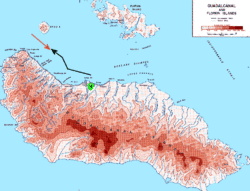
At about 01:25 on November 13, in almost complete pitch darkness because of the bad weather and dark moon, the ships of the Japanese force entered the sound between Savo Island and Guadalcanal and prepared to bombard Henderson Field. Several of the U.S. ships detected the Japanese ships on radar, beginning about 01:24, but had trouble communicating the information to Callaghan because of problems with their ship's radio equipment and lack of discipline with their communications procedures. Several minutes later, both forces visually sighted each other about the same time, but both Abe and Callaghan hesitated ordering their ships into action. Abe apparently was surprised by the proximity of the U.S. ships and could not decide if he should momentarily withdraw to give his battleships time to change from bombardment ammunition to anti-ship ammunition or to continue onward. He decided to continue onward. Callaghan apparently intended to attempt to cross the T of the Japanese, as Scott had done at Cape Esperance, but—confused by the incomplete information he was receiving, plus the fact that the Japanese formation consisted of several scattered groups—he gave several confusing orders on ship movements. The U.S. ship formation began to fall apart, apparently further delaying Callaghan's order to commence firing as he first tried to straighten out his ship's locations. Meanwhile, both forces' formations began to intermingle with each other as the individual ship commanders on both sides anxiously awaited permission to open fire.
At 01:48, Akatsuki and Hiei turned on large searchlights and lit up Atlanta only 3,000 yards (2.7 km) away—almost point-blank range for large naval artillery. Several of the ships on both sides spontaneously opened fire. Realizing that his force was almost surrounded by Japanese ships, Callaghan ordered, "Odd ships fire to starboard, even ships fire to port." Most of the remaining U.S. ships then opened fire, although several had to quickly change their targets in order to comply with Callaghan's order. As the ships from the two sides intermingled, they battled each other in an utterly confused and chaotic melée at close distances. Afterwards, an officer on Monssen likened it to "a barroom brawl after the lights had been shot out".
At least six of the U.S. ships, including Laffey, O'Bannon, Atlanta, San Francisco, Portland, and Helena, fired at Akatsuki, which drew attention to herself with her illuminated searchlight. Akatsuki was hit repeatedly and blew up and sank within a few minutes, but not before hitting Atlanta with shells and a type 93 torpedo.
Perhaps because it was the lead cruiser in the U.S. formation, Atlanta was the target of fire from several Japanese ships, probably including Nagara, Inazuma, and Ikazuchi, in addition to Akatsuki. The gunfire caused Atlanta heavy damage, and the torpedo hit cut all of her engineering power. Atlanta drifted into the line of fire of San Francisco, which accidentally fired on Atlanta, causing even greater damage, and killing Admiral Scott and much of the bridge crew. Atlanta, without power or able to fire her guns, now drifted out of control and out of the battle as the Japanese ships passed her by. The lead U.S. destroyer, Cushing, was also caught in a crossfire between several Japanese destroyers and perhaps Nagara. She too was hit heavily and stopped dead in the water.
Hiei, with her nine lit searchlights, huge size, and course taking her directly through the U.S. formation, became the focus of gunfire from many of the U.S. ships. Laffey passed so close to Hiei that they missed colliding by 20 feet (6 m). Hiei was unable to depress her main or secondary batteries low enough to hit Laffey, but Laffey was able to rake Hiei’s superstructure with 5-inch (130 mm) shells and machine gun fire, causing heavy damage to Hiei’s superstructure and bridge, wounding Admiral Abe, and killing his chief of staff. Admiral Abe was thereafter limited in his ability to direct his ships for the rest of the battle. Sterett and O'Bannon likewise pumped several salvos into Hiei’s superstructure from close range, and perhaps one or two torpedoes into her hull, causing Hiei further damage, before both destroyers escaped into the darkness.
Unable to fire her main or secondary batteries at the three destroyers causing her so much trouble, Hiei instead concentrated on San Francisco which was passing by only 2,500 yards (2.3 km) away. Along with Kirishima, Inazuma, and Ikazuchi, the four ships made repeated hits on San Francisco, disabling her steering control and killing Admiral Callaghan, Captain Cassin Young, and most of the bridge staff. The first few salvos from Hiei and Kirishima consisted of the special fragmentation bombardment shells, which reduced damage to the interior of San Francisco and may have saved her from being sunk outright. Not expecting a ship-to-ship confrontation, it took the crews of the two Japanese battleships several minutes to switch to armor-piercing ammunition. Nevertheless, San Francisco, almost helpless to defend herself, managed to momentarily sail clear of the melee. However, she landed at least one shell in Hiei’s steering gear room during the exchange, flooding it with water, shorting out her power steering generators, and severely inhibiting Hiei’s steering capability. Helena followed San Francisco to try and protect her from further harm.
Two of the U.S. destroyers met a sudden demise. Either Nagara or the destroyers Teruzuki and Yukikaze came upon the drifting Cushing and pounded her with gunfire, knocking out all of her systems. Unable to fight back, Cushing’s crew abandoned ship. Cushing sank several hours later. Laffey, having escaped from her engagement with Hiei, encountered Asagumo, Murasame, Samidare, and, perhaps, Teruzuki. The Japanese destroyers pounded the Laffey with gunfire and then hit her with a torpedo which broke her keel. A few minutes later fires reached her ammunition magazines and she blew up and sank.
Portland, after helping sink Akatsuki, was hit by a torpedo from Inazuma or Ikazuchi, causing heavy damage to her stern and forcing her to steer in a circle. After completing her first loop, she was able to fire four salvos at Hiei but otherwise took little further part in the battle.
Yudachi and Amatsukaze independently charged the rear five ships of the U.S. formation. Two torpedoes from Amatsukaze hit Barton, immediately sinking her with heavy loss of life. Yudachi planted a torpedo in Juneau, stopping Juneau dead in the water, breaking her keel, and knocking out most of her systems. Juneau then turned east and slowly crept out of the battle area.
Monssen avoided the wreck of Barton and motored onward looking for targets. She was accosted by Asagumo, Murasame, and Samidare who had just finished blasting Laffey. They proceeded to smother Monssen with gunfire, damaging her severely and forcing the crew to abandon ship. The ship sank sometime later.
Amatsukaze approached San Francisco with the intention of finishing her off. However, while concentrating on San Francisco, Amatsukaze did not notice the approach of Helena which fired several full broadsides at Amatsukaze from close range and knocked her out of the action. The heavily damaged Amatsukaze escaped under cover of a smoke screen and while Helena was distracted by an attack by Asagumo, Murasame, and Samidare.
Aaron Ward and Sterett, independently searching for targets, both sighted Yudachi, who appeared unaware of the approach of the two U.S. destroyers. Both U.S. ships hit Yudachi simultaneously with gunfire and torpedoes, heavily damaging the destroyer and forcing her crew to abandon ship. The ship did not sink right away, however. Continuing on her way, Sterett was suddenly ambushed by Teruzuki, heavily damaged, and forced to withdraw from the battle area to the east. Aaron Ward wound up in a one-on-one duel with Kirishima, which the destroyer lost with heavy damage. She also tried to retire from the battle area to the east but soon stopped dead in the water because the engines were damaged.
Robert Leckie, a Marine private on Guadalcanal, described the battle:
| “ | The star shells rose, terrible and red. Giant tracers flashed across the night in orange arches. ... the sea seemed a sheet of polished obsidian on which the warships seemed to have been dropped and were immobilized, centered amid concentric circles like shock waves that form around a stone dropped in mud. | ” |
After nearly 40 minutes of the brutal, close-quarters fighting, the two sides broke contact and ceased fire at 02:26 after Abe and Captain Gilbert Hoover (the captain of Helena and senior surviving U.S. officer at this point) ordered their respective forces to disengage. Admiral Abe had one battleship (Kirishima), one light cruiser (Nagara), and four destroyers (Asagumo, Teruzuki, Yukikaze, and Harusame) with only light damage that could continue fighting (Inazuma, Ikazuchi, Murasame, and Samidare were damaged enough that their fighting ability was somewhat impaired). The U.S. had only one light cruiser (Helena) and one destroyer (Fletcher) that were still capable of effective resistance. Although perhaps unclear to Abe, the way was clear for him to bombard Henderson Field and finish off the U.S. naval forces in the area, clearing the way for the troops and supplies to be landed safely on Guadalcanal.
However, at this crucial juncture, Abe chose to abandon the mission and depart the area. Several reasons are conjectured as to why he made this decision. Much of the special bombardment ammunition had been expended in the battle. His own injuries and the deaths of some of his staff from battle action may have affected his thought processes. Perhaps he was also unsure as to how many of his or the U.S. ships were still combat-capable because of communication problems with the damaged Hiei. Furthermore, his own ships were scattered and would have taken some time to reassemble for a coordinated resumption of the mission to attack Henderson Field and the remnants of the U.S. warship force. For whatever reason, Abe called for a disengagement and general retreat of his warships, although Yukikaze and Teruzuki remained behind to assist Hiei. Samidare picked-up survivors from Yudachi at 03:00 before joining the other Japanese ships in the retirement northwards.
Aftermath
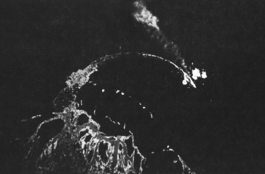
At 03:00 on November 13, Admiral Yamamoto postponed the planned landings of the transports, which returned to the Shortlands to await further orders. Dawn revealed three crippled Japanese (Hiei, Yudachi, and Amatsukaze), and three crippled U.S. ships (Portland, Atlanta, and Aaron Ward) in the general vicinity of Savo Island. Amatsukaze was attacked by U.S. dive-bombers but escaped further damage as she headed to Truk and eventually returned to action several months later. The abandoned hulk of Yudachi was sunk by Portland, whose guns still worked despite the other damage to the ship. The tugboat Bobolink motored around Ironbottom Sound throughout the day of November 13, assisting the crippled U.S. ships, rescuing U.S. survivors from the water, and, reportedly, shooting Japanese survivors floating in the water.
Hiei was attacked repeatedly by Marine TBF Avenger torpedo planes from Henderson Field, TBFs and SBD Dauntless dive-bombers from Enterprise, which had departed Noumea on November 11, and B-17 Flying Fortress bombers of the United States Army Air Forces 11th Heavy Bombardment Group from Espiritu Santo. Abe and his staff transferred to Yukikaze at 08:15. Kirishima was ordered by Abe to take Hiei under tow, escorted by Nagara and its destroyers, but the attempt was cancelled because of the threat of submarine attack and Hiei's increasing unseaworthiness. After sustaining more damage from air attacks, Hiei sank northwest of Savo Island, perhaps after being scuttled by her remaining crew, in the late evening of November 13.
Portland, San Francisco, Aaron Ward, Sterett, and O'Bannon were eventually able to make it back to rear-area ports for repairs. Atlanta, however, sank near Guadalcanal at 20:00 on November 13. Departing from the Solomon Islands area with San Francisco, Helena, Sterret, and O'Bannon later that day, Juneau was torpedoed and sunk by Japanese submarine I-26 (). Juneau’s 100+ survivors (out of a total complement of 650) were left to fend on their own in the open ocean for eight days before rescue aircraft belatedly arrived. While awaiting rescue, all but 10 of Juneau’s crew died from their injuries, the elements, or shark attacks. The dead included the five Sullivan brothers.
Because of the confused nature of the battle, the U.S. believed that they had sunk as many as seven Japanese ships. This, plus the Japanese retreat, caused the U.S. to believe at the time that they had won a significant victory. It was only after the war that the U.S. learned that they had suffered what most see as a crushing tactical defeat.
Nevertheless, most historians appear to agree that Abe's decision to retreat turned this tactical defeat into a strategic victory for the U.S. Henderson Field remained operational with attack aircraft ready to deter the slow Japanese transports from approaching Guadalcanal with their precious cargoes. Plus, the Japanese had lost an opportunity to eliminate the U.S. naval forces in the area, a result which would have taken even the comparatively resource-rich U.S. some time to recover from. Reportedly furious, Admiral Yamamoto relieved Abe of command and later directed his forced retirement from the military. However, it appears that Yamamoto may have been more angry over the loss of one of his battleships (Hiei) than he was over the abandonment of the supply mission and failure to completely destroy the U.S. force. Shortly before noon, Yamamoto ordered Vice Admiral Nobutake Kondo, commanding the Second Fleet at Truk, to form a new bombardment unit around Kirishima and attack Henderson Field on the night of November 14– November 15.
Including the sinking of Juneau, total U.S. losses in the battle were 1,439 dead. The Japanese suffered between 550 to 800 dead. Analyzing the impact of this engagement, historian Richard B. Frank states,
| “ | This action stands without peer for furious, close-range, and confused fighting during the war. But the result was not decisive. The self-sacrifice of Callaghan and his task force had purchased one night's respite for Henderson Field. It had postponed, not stopped, the landing of major Japanese reinforcements, nor had the greater portion of the (Japanese) Combined Fleet yet been heard from." | ” |
Other actions, November 13–14
Although the reinforcement effort to Guadalcanal was delayed, the Japanese did not give up trying to complete the original mission, albeit a day later than originally planned. In the afternoon of November 13, Tanaka and the 11 transports resumed their journey towards Guadalcanal. A Japanese force of cruisers and destroyers from the 8th Fleet, based primarily at Rabaul and originally assigned to cover the unloading of the transports on the evening of November 13, was given the mission that Abe's force had failed to carry out—the bombardment of Henderson Field. The battleship Kirishima, after abandoning its rescue effort of Hiei on the morning of November 13, steamed north between Santa Isabel and Malaita Islands with her accompanying warships to rendezvous with Kondo's Second Fleet inbound from Truk to form the new bombardment unit.
The 8th Fleet cruiser force, under its commander, Vice Admiral Gunichi Mikawa, included the heavy cruisers Chōkai, Kinugasa, Maya, and Suzuya, light cruisers Isuzu and Tenryū, and six destroyers. Mikawa's force was able to slip into the Guadalcanal area uncontested because the battered U.S. naval forces had withdrawn. Suzuya and Maya, under the command of Shōji Nishimura, bombarded Henderson Field while the rest of Mikawa's force cruised around Savo Island guarding against any U.S. surface attack (which did not occur). The 35-minute bombardment caused some damage to various aircraft and facilities at the airfield but did not put it out of operation. The cruiser force ended the bombardment around 02:30 on November 14 and cleared the area to head towards Rabaul on a course south of the New Georgia island group. At daybreak, aircraft from Henderson Field, Espiritu Santo, and Enterprise, stationed 200 nmi (370 km) south of Guadalcanal, began their attacks, first on Mikawa's force that was heading away from Guadalcanal, and then on the transport force heading towards Guadalcanal. The attacks on Mikawa's force sank Kinugasa, killing 511 of her crew, and damaged Maya, forcing her to go to Japan for repairs. Repeated air attacks on the transport force overwhelmed the escorting Japanese fighter aircraft, sank six of the transports, and forced one more to turn back with heavy damage (it later sank). Survivors from the transports were rescued by the convoy's escorting destroyers and returned to the Shortlands. A total of 450 army troops were reported to have perished.
The remaining four transports and four destroyers continued towards Guadalcanal after nightfall of November 14 but stopped west of Guadalcanal to await the finish of the warship surface action (below) before continuing.
Kondo's ad hoc force rendezvoused at Ontong Java on the evening of November 13, then reversed course and refueled out of range of Henderson Field's bombers on the morning of November 14. The US submarine Trout stalked but was unable to attack Kirishima during refueling. The bombardment force continued south and came under air attack late in the afternoon of November 14, during which they were intercepted by the submarine Flying Fish which launched five torpedoes but scored no hits, then reported its contact by radio.
Second Naval Battle of Guadalcanal, November 14–15
Prelude
To cover the unloading of the transports at Guadalcanal, the Japanese fleet made its third attempt to neutralize Henderson Field, sending the force of warships under Admiral Kondo through Indispensable Strait to bombard Guadalcanal on the night of November 14– November 15. The force included Kirishima, heavy cruisers Atago and Takao, light cruisers Nagara and Sendai, and nine destroyers, some of the destroyers being survivors (along with Kirishima and Nagara) of the first night engagement two days prior. Kondo flew his flag in the cruiser Atago. The force approached Guadalcanal around midnight, and a quarter moon provided moderate visibility of about seven kilometers.
Low on undamaged ships, Admiral William Halsey, Jr., detached the new battleships Washington and South Dakota, of Enterprise’s support group, together with four destroyers, as Task Force 64 under Admiral Willis A. Lee to defend Guadalcanal and Henderson Field. It was a scratch force; the battleships had only operated together for a few days, and their four escorts were from four different divisions—chosen simply because, of the available destroyers, they had the most fuel. The U.S. force arrived in Ironbottom Sound in the evening of November 14 and began patrolling around Savo Island. The U.S. warships were in column formation with the four destroyers in the lead, followed by Washington, with South Dakota bringing up the rear. At 22:55 on November 14, radar on the South Dakota and Washington began to detect Kondo's oncoming ships near Savo Island around 18,000 m range.
Action
Kondo split his force into several groups, with one group, commanded by Shintaro Hashimoto and consisting of Sendai and destroyers Shikinami and Uranami ("C" on the maps), sweeping along the east side of Savo Island, and destroyer Ayanami ("B" on the maps) sweeping counterclockwise around the southwest side of Savo Island to check for the presence of Allied ships. The Japanese ships spotted Lee's force around 23:00, though Kondo misidentified the battleships as cruisers. Kondo ordered the Sendai group of ships, plus Nagara and four destroyers ("D" on the maps) to engage and destroy the U.S. force before he brought the bombardment force of Kirishima and heavy cruisers ("E" on the maps) into Ironbottom Sound. The U.S. ships ("A" on the maps) detected the Sendai force on radar but did not detect the other groups of Japanese ships. Using radar targeting, the two U.S. battleships opened fire on the Sendai group at 23:17. Admiral Lee ordered a cease fire about five minutes later after the radar returns on the northern group appeared to disappear from his ship's radar scopes. However, Sendai, Uranami, and Shikinami were undamaged and circled out of the danger area.
Meanwhile, the four U.S. destroyers in the vanguard of the U.S. formation began engaging both Ayanami and the Nagara group of ships at 23:22. Nagara and her escorting destroyers responded effectively with accurate gunfire and torpedoes, and destroyers Walke and Preston were hit and sunk within 10 minutes with heavy loss of life. The destroyer Benham had part of her bow blown off by a torpedo and had to retreat (she sank the next day), and destroyer Gwin was hit in her engine room and put out of the fight. However, the U.S. destroyers had completed their mission as screens for the battleships, absorbing the initial impact of contact with the enemy, although at great cost. Lee ordered the retirement of Benham and Gwin at 23:48.
Washington passed through the area still occupied by the damaged and sinking U.S. destroyers and fired on Ayanami with her secondary batteries, setting her afire. Following close behind, South Dakota suddenly suffered a series of electrical failures, reportedly during repairs when her chief engineer locked down a circuit breaker in violation of safety procedures, causing her circuits repeatedly to go into series, making her radar, radios, and most of her gun batteries inoperable. However, she continued to follow Washington towards the western side of Savo Island until 23:35, when Washington changed course left to pass to the southward behind the burning destroyers. South Dakota tried to follow but had to turn to right to avoid Benham which resulted in the ship being silhouetted by the fires of the burning destroyers and made her a closer and easier target for the Japanese.
Receiving reports of the destruction of the U.S. destroyers from Ayanami and his other ships, Kondo pointed his bombardment force towards Guadalcanal, believing that the U.S. warship force had been defeated. His force and the two U.S. battleships were now heading towards each other.
Almost blind and unable to effectively fire her main and secondary armament, South Dakota was illuminated by searchlights and targeted by gunfire and torpedoes by most of the ships of the Japanese force, including Kirishima, beginning about 00:00 on November 15. Although able to score a few hits on Kirishima, South Dakota took 25 medium and one large-caliber hit, some of which did not explode, that completely knocked out her communications and remaining gunfire control operations, set portions of her upper decks on fire, and forced her to try to steer away from the engagement. All of the Japanese torpedoes missed. Admiral Lee later described the cumulative effect of the gunfire damage to South Dakota as to, "render one of our new battleships deaf, dumb, blind, and impotent." South Dakota's crew casualties were 39 killed and 59 wounded, and she turned away from the battle at 00:17 without informing Admiral Lee, though observed by Kondo's lookouts.
The Japanese ships continued to concentrate their fire on South Dakota and none detected Washington approaching to within 9,000 yards (8 km). Washington was tracking a large target (Kirishima) for some time but refrained from firing since there was a chance it could be South Dakota. Washington had not been able to track South Dakota’s movements because she was in a blind spot in the Washington’s radar and Lee could not raise her on the radio to confirm her position. When the Japanese illuminated and fired on South Dakota, all doubts were removed as to which ships were friend or foe. From this close range, Washington opened fire and quickly hit Kirishima with at least nine main battery shells and almost forty secondary ones, causing heavy damage and setting her aflame. Kirishima was hit below the waterline and suffered a jammed rudder, causing her to circle uncontrollably to port.
At 00:25 Kondo ordered all of his ships that were able to converge and destroy any remaining U.S. ships. However, the Japanese ships still did not know where Washington was located, and the other surviving U.S. ships had already departed the battle area. Washington steered a northwesterly course towards the Russell Islands to draw the Japanese force away from Guadalcanal and the presumably damaged South Dakota. The Japanese ships finally sighted Washington and launched several torpedo attacks, but by adroit maneuvering by her captain, Washington avoided all of them and also avoided grounding his ship in shallow waters. At length, believing that the way was clear for the transport convoy to proceed to Guadalcanal (but apparently disregarding the threat of air attack in the morning), Kondo ordered his remaining ships to break contact and retire from the area about 01:04, which most of the Japanese warships complied with by 01:30.
Aftermath
Both Kirishima and Ayanami were scuttled and sank by 03:25, November 15. Uranami rescued survivors from Ayanami and destroyers Asagumo, Teruzuki, and Samidare rescued the remaining crew from Kirishima. In the engagement, 242 U.S. and 249 Japanese sailors died. The engagement was one of only two battleship-against-battleship surface battles in the entire Pacific campaign of World War II, the other being at the Surigao Strait during the Battle of Leyte Gulf.
The four Japanese transports beached themselves at Tassafaronga on Guadalcanal by 04:00, November 15 and Tanaka and the escort destroyers departed and raced back up the Slot towards safer waters. The transports were attacked, beginning at 05:55 by U.S. aircraft from Henderson Field and elsewhere, and field artillery from U.S. ground forces on Guadalcanal. Later, destroyer Meade approached and opened fire on the beached transports and surrounding area. These attacks set the transports afire and destroyed any equipment on them that the Japanese had not managed to quickly unload. Only 2,000–3,000 of the troops originally embarked actually made it to Guadalcanal, and most of their ammunition and food supplies were lost.
Yamamoto's reaction to Kondo's failure to accomplish his mission of neutralizing Henderson Field and ensuring the safe landing of troops and supplies was milder than his earlier reaction to Abe's withdrawal, perhaps because of Imperial Navy culture and politics. Kondo, who also held the position of second in command of the Combined Fleet, was a member of the upper staff and battleship "clique" of the Imperial Navy while Abe was a career destroyer specialist. Admiral Kondo was not reprimanded or reassigned but instead was left in command of one of the large ship fleets based at Truk.
Significance
The failure to deliver to Guadalcanal most of the troops and supplies in the convoy prevented the Japanese from launching another offensive to retake Henderson Field. Thereafter, the Japanese Navy was only able to deliver subsistence supplies and a few replacement troops to Japanese Army forces on Guadalcanal. Because of the continuing threat from Allied aircraft based at Henderson Field, plus nearby U.S. aircraft carriers, the Japanese had to continue to rely on Tokyo Express warship deliveries to their forces on Guadalcanal. However, these supplies and replacements were not enough to sustain Japanese troops on the island, who by December 7, 1942, were losing about 50 men each day from malnutrition, disease, and Allied ground or air attacks. On December 12, the Japanese Navy proposed that Guadalcanal be abandoned. Despite opposition from Japanese Army leaders, who still hoped that Guadalcanal could eventually be retaken from the Allies, Japan's Imperial General Headquarters, with approval from the Emperor, on December 31, 1942, agreed to the evacuation of all Japanese forces from the island and establishment of a new line of defense for the Solomons on New Georgia.
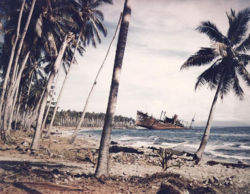
Thus, the Naval Battle of Guadalcanal was the last major attempt by the Japanese to seize control of the seas around Guadalcanal or to retake the island. In contrast, the U.S. Navy was thereafter able to resupply the U.S. forces at Guadalcanal at will, including the delivery of two fresh divisions by late December 1942. The inability to neutralize Henderson Field doomed the Japanese effort to successfully combat the Allied conquest of Guadalcanal. The last Japanese resistance in the Guadalcanal campaign ended on February 9, 1943, with the successful evacuation of most of the surviving Japanese troops from the island by the Japanese navy in Operation Ke. Building on their success at Guadalcanal and elsewhere, the Allies continued their campaign against Japan, ultimately culminating in Japan's defeat and the end of World War II. U.S. President Franklin Roosevelt, upon learning of the results of the battle commented, "It would seem that the turning point in this war has at last been reached."
Historian Eric Hammel sums up the significance of the Naval Battle of Guadalcanal this way:
| “ | On November 12, 1942, the (Japanese) Imperial Navy had the better ships and the better tactics. After November 15, 1942, its leaders lost heart and it lacked the strategic depth to face the burgeoning U.S. Navy and its vastly improving weapons and tactics. The Japanese never got better while, after November 1942, the U.S. Navy never stopped getting better. | ” |
General Alexander Vandegrift, the commander of the troops on Guadalcanal, paid tribute to the sailors who fought the battle:
| “ | We believe the enemy has undoubtedly suffered a crushing defeat. We thank Admiral Kinkaid for his intervention yesterday. We thank Lee for his sturdy effort last night. Our own aircraft has been grand in its relentless hammering of the foe. All those efforts are appreciated but our greatest homage goes to Callaghan, Scott and their men who with magnificent courage against seemingly hopeless odds drove back the first hostile attack and paved the way for the success to follow. To them the men of Cactus lift their battered helmets in deepest admiration. | ” |
